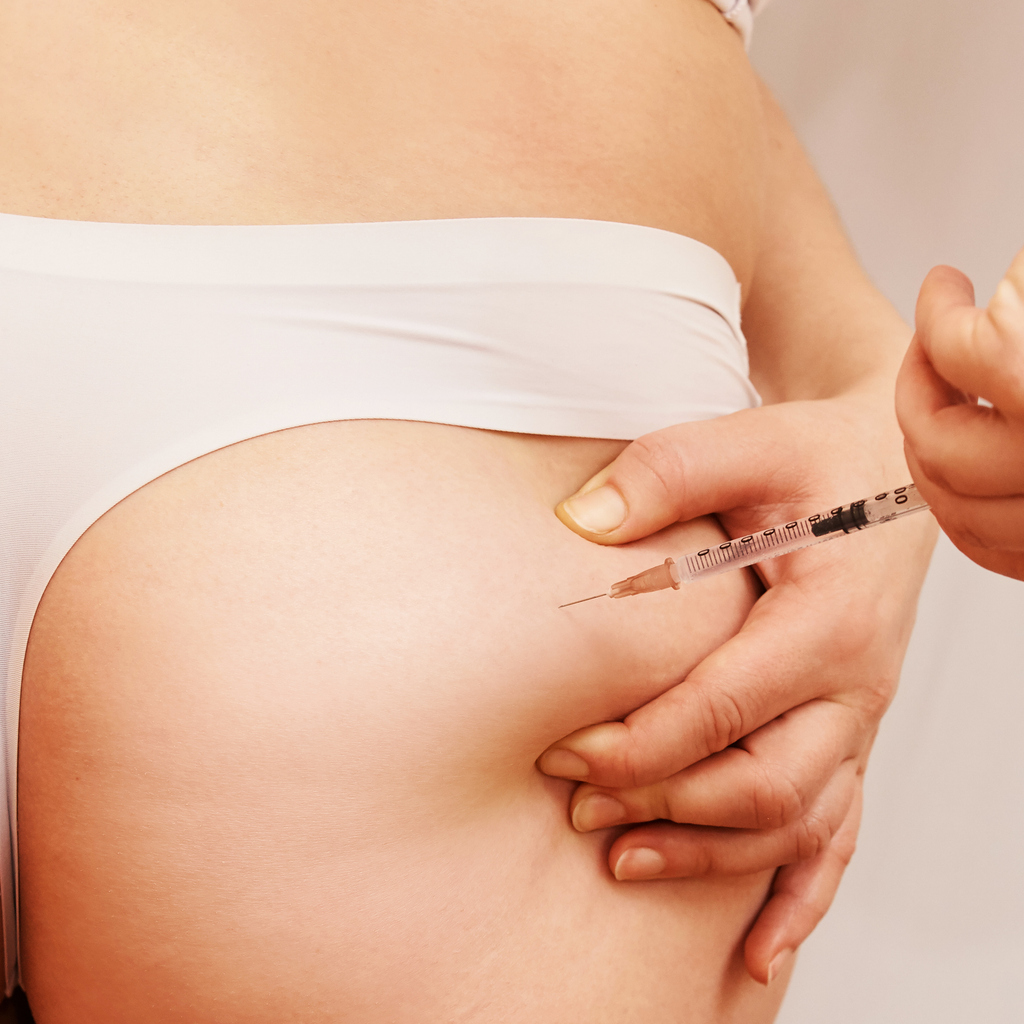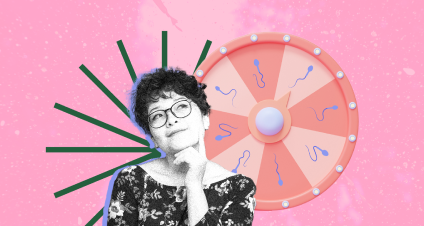Of all the medications you prepare for during IVF, progesterone in oil (PIO) often feels like the one no one really warns you about — until you're already deep in it. And that was certainly true for IVF mom, writer, and library worker, Lindsey Williams — after 5 years of trying to conceive with dual-factor infertility, she is (at the time of writing) expecting her first child conceived with the help of IVF.
Like many others navigating IVF, Lindsey knew she’d need to take progesterone in oil injections as part of her frozen embryo transfer (FET) protocol. But knowing and doing are two very different things.
“I will be the first to admit: that from the beginning, one of the most terrifying and daunting aspects of pursuing IVF to grow my family was the idea of PIO, or progesterone in oil, injections. Multiple shots a day in the stomach during the egg retrieval stimulation phase? No problem! [But] the needles for the necessary stimulation drugs leading up to egg retrieval (in my case a daily cocktail of Menopur, Gonal-F, and Cetrotide) were tiny in comparison to the giant needles I had seen people use for PIO.”
This is her story — and the story of so many others who've developed a complicated, necessary relationship with PIO.

What is PIO in IVF?
Progesterone in oil (often shortened to PIO) is a form of progesterone given by intramuscular injection during IVF. In a natural cycle, your ovaries produce progesterone to help prepare the uterus for pregnancy. But in a medicated embryo transfer cycle, your body needs extra support — and that’s where PIO comes in.
It thickens the uterine lining, helps the embryo implant, and supports early pregnancy until the placenta can take over hormone production — usually around 8 to 12 weeks.
As Lindsey explains, “In a frozen embryo transfer cycle, PIO injections are used as a replacement for your body’s natural progesterone hormone which would normally be produced by the ovaries in early pregnancy. Progesterone helps to prepare the uterine lining, which encourages the embryo to implant, or ‘stick’. The injections continue to supplement a patient’s natural progesterone after a successful embryo transfer until 8-12 weeks, at which point the placenta has taken over.”
IVF drug schedule: When PIO shots begin
The PIO injection is typically started a few days before embryo transfer and continues daily. For many people, it becomes part of a nightly routine that feels equal parts clinical and deeply emotional.
Where to inject progesterone in oil
PIO injections go into the upper outer quadrant of the glute (your butt cheek, basically). Not exactly an easy place to reach solo. That’s why many people rely on a partner or support person to help. Lindsey’s husband took on this role.
It’s important to rotate sides and avoid the same spot each night to minimize soreness.
PIO injection site tips
Lindsey initially found the idea of injecting progesterone daunting (it’s a whole new experience, after all), but found some techniques that worked for her: “To prepare for my first progesterone in oil injection, I watched countless PIO Instagram videos from sweet people all over the world who shared their IVF journeys. In doing so, I saw a variety of methods: injecting while standing up, lying down, solo, with a partner, heating afterward, squats afterward, or my personal favorite, the “slap method” (coined by Monica from @monicas_so_called_life). Once the day came to begin PIO on our own journey, my husband and I felt as prepared as we were going to get.”
If it’s your first time with PIO injections for IVF, here are some recommended tips:
- Correct spot: Upper outer glute — the ‘ventrogluteal’ or ‘dorsogluteal’ muscle.
- What to avoid: Injecting too low, too central, or into fat tissue can cause bruising, irritation, or reduce absorption.
- Signs of a bad injection site: Burning, swelling, knots, or radiating pain.
What happens if you inject in the wrong place?
If you think you’ve injected progesterone in the wrong place, don’t panic. Apply heat, massage the area, and note it for next time. But if you notice a lot of swelling or redness, check in with your provider.

Progesterone in oil side effects
Like many fertility medications (and, let’s face it, pretty much every medication ever), there may be some side effects to progesterone in oil injections. Common PIO side effects include:
- Pain or tenderness at the injection site
- Lumps or knots under the skin
- Itching or bruising
- Hormonal symptoms like mood swings or fatigue
Some people also report feeling emotionally affected — a reminder that hormones don’t just support the uterus, they affect your entire system.
How to get rid of lumps from progesterone injections
Those hard lumps? You're not alone. Lindsey experienced them, too: “I have hard knots in places I never wanted or imagined I would have knots.”
Here are a few strategies to help:
- Heat before and after injecting
- Massage the area gently for 5–10 minutes
- Walk or stretch to help disperse the oil
- Rotate sides and injection spots regularly
Can you take progesterone in oil at different times?
Your clinic will usually recommend giving your PIO shots at the same time every day. This helps keep progesterone levels stable to support your lining and embryo.
If you’re late by an hour or two, it’s unlikely to cause major issues — but always check with your provider if you miss a dose or need to adjust your timing regularly.

When to stop progesterone after IVF
Most clinics stop progesterone in oil injections between 8 and 12 weeks of pregnancy. That’s about 6–10 weeks after your embryo transfer, depending on your protocol. It is safe to take progesterone shots during pregnancy for a certain amount of time, if suggested by your doctor.
At that point, your placenta should be producing enough hormones to support the pregnancy on its own — including both progesterone and estradiol (estrogen).
But emotionally, it can be hard to let go, as Lindsey explains:
“Right now, at 48 progesterone injections and counting, I am over it. It is my least favorite part of every evening. So, why is it that I feel a slight-but-steadily-increasing panic as I near the end of these injections I’ve been fed up with practically since they started?
I found myself counting down the days until they would be over 24 as of today — but as the date of the last one nears, I inexplicably find myself afraid to stop. These dreaded shots, as despised as they have been, have helped me stay pregnant. They have been keeping this amazing daughter inside of me alive.
Speaking with my therapist about this, she said something that struck me: I am going to be worried about her for the rest of my life. This is just the beginning. But I have to trust that I am capable of keeping her safe, even at this earliest stage, when it will become entirely up to my body.
So, how do I trust my body with this monumental job, when it’s taken so many drugs and medical interventions to get to this point in the first place?
I have to remind myself of the fact that this is a normal part of this process, a process in which so many things feel so abnormal compared to what I imagined having a baby would look like. But it is generally normal to stop IVF drugs, including progesterone in oil and estrogen, in the weeks following a successful embryo transfer.
My personal stopping point is 12 weeks, the end of my first trimester. Once I reach this point, it is safe to stop the progesterone injections because science has shown that my body is capable of taking over entirely on its own from here. At 12 weeks, my body is producing all of the necessary hormones on its own, and my baby is getting all that she needs from my placenta.
This is what I try to continuously call to my mind every evening as I count down my remaining injections — every time I sanitize our shot station, prep my syringe, clean the injection site, and hand my husband the needle.”
Stopping progesterone at 10 weeks after IVF
Some protocols stop PIO shots at 10 weeks instead of 12. This can vary depending on the clinic, the patient, and whether you’ve had any complications or previous losses.
If you’re unsure about when to stop your medication, talk with your fertility clinic. They’ll base the decision on hormone levels, ultrasound results, and your personal history.
How long to take estradiol after embryo transfer?
Much like progesterone, estradiol is often stopped between weeks 8 and 12 once the placenta takes over hormone production. Your clinic may taper your dose or have you stop cold turkey — both are common, depending on your circumstances, situation, and medical history.

What does progesterone do after a canceled egg retrieval cycle?
If your IVF cycle is cancelled after stimulation but before transfer, your clinic may still prescribe progesterone to trigger a withdrawal bleed or support your cycle in other ways.
In a canceled cycle, progesterone isn’t supporting a pregnancy, but it may still play a role in resetting your hormones or prepping your body for your next attempt.
Progesterone in oil cost: is it expensive?
We’ll be honest — fertility meds aren’t cheap. Progesterone in oil costs vary by pharmacy and insurance coverage, but you might expect to pay anywhere from $50 to $200 per vial without coverage.
Many patients use 1 vial every 5–7 days, depending on dosage.

“They’ve brought me this far, but… I can take it from here.”
If you’re in the thick of it — sore, tired, counting down the days — you're not alone. Lindsey’s experience is shared by thousands of people navigating PIO IVF protocols and trying to hold onto hope in a deeply medicalised process.
“I am one step closer to not medically necessitating these injections, even though they feel like a safety net I’m afraid to leave behind. They’ve brought me this far, but I know that I can take it from here.”
Progesterone in oil might be one of the hardest parts of IVF — not just physically, but emotionally too. But when you’re ready to stop, trust that your body knows what to do next. And trust that you’ve already done more than enough.
Tassia O'Callaghan is an experienced content writer and strategist, having written about a vast range of topics from chemical regulations to parenting, for brands like Peanut App Ltd, Scary Mommy, Tally Workspace, and Fertility Mapper. She's an advocate for realistic sustainable living, supporting small businesses (author of A-Z of Marketing for Small Businesses), and equity across all walks of life. Follow her on LinkedIn or TikTok, or see more of her work on Authory or her website.




.jpeg)

.jpeg)

.webp)










